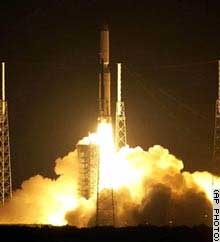|
KENNEDY SPACE CENTER, Florida (CNN) --
The Air Force launched a top-secret satellite Tuesday
for the National Reconnaissance Office, which operates
the United States' fleet of spy spacecraft.
 A
Titan IV-B rocket was used to launch the large
spacecraft, believed to be an electronics listening
satellite, into a position 22,300 miles above the
Earth's equator. A
Titan IV-B rocket was used to launch the large
spacecraft, believed to be an electronics listening
satellite, into a position 22,300 miles above the
Earth's equator.
The National Reconnaissance Office would not reveal any
details about the satellite, including its cost, purpose
or which contractor built it.
"I cannot discuss what the payload is other than to tell
you that it will provide additional capabilities for our
nation's leadership and military," said Art Haubold, a
spokesman for the NRO.
This particular satellite was delayed for more than
three years due to technical problems and had been
scheduled for launch as recently as several months ago.
The NRO's electronics listening satellites use baseball
diamond-size antennas which fold up like an umbrella for
launch.
The large antennas permit the satellite to monitor
extremely faint signals, even individual cell phone
conversations.
It's believed that similar satellites have been used to
monitor and track terrorists.
Astronomer and satellite observer Ted Molczan said:
"These satellites are so large they can be seen in high
quality backyard telescopes. Some amateur satellite
observers have photographed these satellites in their
operational locations." The new
heavy-duty spy satellite for the National Reconnaissance
Office (NRO) arrived in Earth orbit Tuesday following a
successful ride into space atop the United States' most
powerful unmanned rocket -- we think.
Following a stricter policy than seen before, launch
commentary was concluded about 19 minutes into flight
and NRO officials said they would not confirm anything
more, including spacecraft separation, which is the
point where a launch is declared a success or failure.
What is known is that the nearly six-hour satellite
delivery mission began at 12:29 a.m. EDT Tuesday (0429
GMT) with the launch of an Air Force Titan 4B rocket
from Cape Canaveral Air Force Station.
Equipped for the final time in history with a Centaur
upper stage, the Lockheed Martin Titan 4B (B-36) rocket
worked flawlessly as it carried the NRO spacecraft
toward geosynchronous orbit.
The flight began with the ignition of the rocket's twin
solid rocket boosters and a quick climb through a low
cloud deck that created a spectacular display of light
and shadows over Florida's Space Coast.
Two minutes and 11 seconds later the twin-engines of the
Titan's core first stage fired up, allowing the spent
boosters to be jettisoned about 15 seconds later. Three
brilliant points of light could be followed as the
boosters fell and the Titan continued on its way.
A burn of the Titan 4B's second stage, followed by the
first of three planned burns of the high-energy Centaur
upper stage were confirmed before officials stopped
providing updates.
If all went well from there, the Centaur upper stage
would have placed the NRO spacecraft into a
geosynchronous transfer orbit about 27 minutes after
launch.
Then a long 5.5-hour coast period followed as the
Centaur upper stage and its still-attached spacecraft
climbed 22,300 miles above the planet. A third Centaur
burn was to circularize the orbit and set up conditions
for spacecraft separation.
Just about 6:15 a.m. EDT (1015 GMT) the NRO platform was
to be successfully delivered into its proper orbit and
launch officials could then declare a success.
Officials won't release any details as to the exact
nature of the NRO satellite, which industry observers
believe is a signals intelligence spacecraft, capable of
eavesdropping on electronic communications of all types.
That conclusion is based on known facts such as the
flight path of the Titan 4B at launch, the inclusion of
a Centaur upper stage on the vehicle as well as the size
of the rocket's nose cone, which in this case is 86 feet
(26 meters) long.
It is expected the spacecraft will provide the nation's
top military leaders and policy makers with information
needed to execute the war against terrorism, as well as
keep tabs on other hot spots around the world.
Unspecified problems with the spacecraft last year and
the desire to launch a MILSTAR communications platform
earlier this year delayed the launch to late this
summer.
An attempt to launch in August was delayed because of a
propellant leak at complex 40. After that spill was
taken care of, a battery problem on the rocket and
another issue with the spacecraft delayed the shot to
Monday night.
A planned 11:12 p.m. EDT Monday (0312 GMT Tuesday) blast
off was delayed at the last minute by concerns raised
about a temperature reading on the Centaur upper stage.
Engineers determined the indication would not be a
problem and, after waiting about 30 minutes for some new
weather balloon data to be processed, re-set the launch
time and picked up the countdown again.
Although Centaur hardware will continue to fly on other
rockets, Tuesday's shot marked the last time the
Titan-Centaur combination would fly as there are just
three more Titan 4's left to fly and none of those
missions requires the extra lifting power of the
Centaur.
Titan-Centaur combinations have carried some of the most
important missions in space program history, including
both Viking probes to Mars and both Voyager probes to
the outer planets.
Two more Titan 4's are scheduled for launch from the
Cape through 2004, and the final Titan 4 is to fly from
Vandenberg Air Force Base in California during 2005.
|